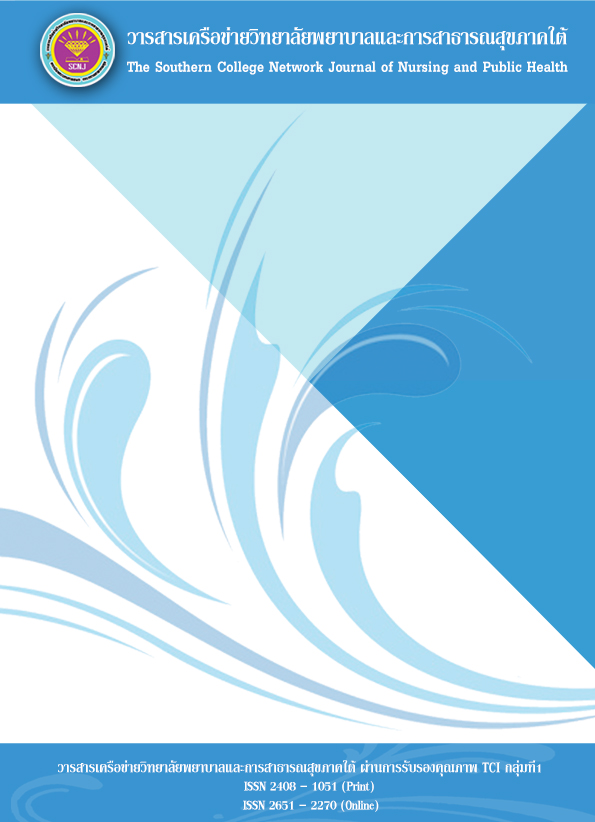การพัฒนารูปแบบการสอนด้วยวิธีที่หลากหลาย (Didactic Teaching) โดยใช้รูปแบบการเรียนรู้ VARK ต่อทักษะการคิดเชิงวิเคราะห์ ของนักศึกษาหลักสูตรสาธารณสุขชุมชน
คำสำคัญ:
การสอนด้วยวิธีที่หลากหลาย, การคิดเชิงวิเคราะห์, นักศึกษาหลักสูตรสาธารณสุขชุมชนบทคัดย่อ
การวิจัยและพัฒนานี้ มีวัตถุประสงค์เพื่อศึกษา 1) แบบแผนการเรียนรู้ (Learning Styles: VARK) 2) พัฒนารูปแบบการสอนด้วยวิธีที่หลากหลาย (Didactic Teaching) และ 3) ประสิทธิผลของรูปแบบการสอนด้วยวิธีที่หลากหลายต่อทักษะการคิดเชิงวิเคราะห์ ของนักศึกษาหลักสูตรสาธารณสุขชุมชน วิทยาลัยการสาธารณสุขสิรินธร จังหวัดสุพรรณบุรี ดำเนินการ 3 ขั้นตอน ได้แก่ ขั้นตอนที่ 1 ศึกษาแบบแผนการเรียนรู้ VARK ในนักศึกษาหลักสูตรสาธารณสุขชุมชน ชั้นปีที่ 3 และ 4 จำนวน 76 คน เครื่องมือที่ใช้เป็นแบบประเมินแบบแผนการเรียนรู้ ได้ค่าความตรง เท่ากับ 1.00 ขั้นตอนที่ 2 พัฒนารูปแบบการสอนด้วยวิธีที่หลากหลาย โดยผู้วิจัยนำผลการวิจัยจากขั้นตอนที่ 1 และการทบทวนวรรณกรรมมายกร่างรูปแบบ ผ่านการตรวจสอบจากผู้ทรงคุณวุฒิ 3 ท่าน เพื่อพิจารณาความเหมาะสม ความเป็นไปได้ และประโยชน์ต่อนักศึกษา ขั้นตอนที่ 3 ศึกษาประสิทธิผลของรูปแบบการสอนด้วยวิธีที่หลากหลาย กลุ่มตัวอย่างเป็นนักศึกษาหลักสูตรสาธารณสุขชุมชน ชั้นปีที่ 3 และ 4 จำนวน 74 คน เครื่องมือที่ใช้ในการวิจัยเป็นแบบสอบถามการคิดเชิงวิเคราะห์ ได้ค่า ความตรงระหว่าง .67 – 1.00 และได้ค่าความเชื่อมั่นสัมประสิทธิ์แอลฟ่าของครอนบาคเท่ากับ .801 วิเคราะห์ข้อมูลโดยใช้สถิติเชิงพรรณนา และสถิติ Paired t-test ผลวิจัยพบว่า
- นักศึกษาหลักสูตรสาธารณสุขชุมชน ร้อยละ 47.37 มีแบบแผนการเรียนรู้จากการดูหรือมองเห็น รองลงมาร้อยละ 22.37 มีแบบแผนการเรียนรู้จากการฟังหรือได้ยิน ร้อยละ 17.10 มีการเรียนรู้จากการอ่านหรือการเขียน และร้อยละ 13.16 มีการเรียนรู้จากการสัมผัสหรือเคลื่อนไหวร่างกาย น้อยที่สุด
- รูปแบบการสอนด้วยวิธีที่หลากหลาย (Didactic Teaching) ต่อทักษะการคิดเชิงวิเคราะห์เน้นการดูและการมองเห็น ประกอบด้วยกิจกรรม 1) การประเมินแบบแผนการเรียนรู้ (VARK) 2) การใช้คลิป Youtube 3) การใช้เกมส์ Kahoot 4) การใช้เกมส์เพื่อประเมินภาวะสุขภาพ จาก Appication Mentimeter 5) การนำเสนอรายงาน และ 6) การสะท้อนคิดด้วยวาจา
- หลังเรียนรายวิชาเศรษฐศาสตร์สาธารณสุขโดยการสอนด้วยวิธีที่หลากหลาย มีทักษะการคิดเชิงวิเคราะห์ (M= 3.88, SD= 0.43) สูงกว่าก่อนเรียน (M= 3.66, SD= 0.34) อย่างมีนัยสำคัญทางสถิติที่ระดับ .001 (p<.001)
ควรมีการประเมินความถนัดในการรับรู้ข้อมูลของผู้เรียนร่วมกับการจัดการเรียนสอนด้วยวิธีที่หลากหลาย (Didactic Teaching) เพื่อเพิ่มผลสัมฤทธิ์ของการศึกษาอีกทั้งยังสามารถพัฒนาทักษะการคิดเชิงวิเคราะห์ให้กับผู้เรียนได้อย่างมีประสิทธิภาพ
References
Alkhasawneh, I. M., Mrayyan, M. T., Docherty, C., Alashram, S., & Yousef, H. Y. (2008). Problem-Based Learning (PBL): Assessing Students’ Learning Preferences Using VARK. Nurse Education Today, 28(5), 572-579.
Bloom, S. B. (1956). Taxonomy of Education Objectives Book.: Cogniyive Domain. London: Longman Group Company.
Chareonwongsak, K. (2010). Analytical Thinking. (6th ed.). Bangkok: Success Media. (in Thai)
Duff, A. (2000) Learning Style of UK Higher Education Students: Four Studies of the Reliability and Replicability of the Learning Style Questionnaire (LSQ). Bristol Business School Teaching and Research Review, 14(3), 131-177.
Fleming, N. D. (2009). VARK: A Guide to Learning Styles. (Version 7.1). Retrieved April 20, 2019 from http://www. varklearn.com/english/index.asp
Government Gazette. (1999). "Educational Management Guidelines". (1999, 19 August), Issue No. 116, Episode 74, Kor., Page 10. (in Thai)
Hair, F. J., Black, C. W., Babin, J. B., & Anderson, E. R. (2010). Multivariate Data Analysis. (7th ed). New Jersey: Pearson Education.
Hamdani, D. A (2010). Exploring Students’Learning Style at a Gulf University: A Contributing Factor to Effective Instruction, 7(C), 652-660.
Hawk, F. K. (2007). Using Learning Style Instruments to Enhance Student Learning. Decision Science Journal of Innovative Education, 5(1), 1-19.
Ibrahim, R. H., & Hussein, D. A. (2016). Assessment of Visual, Auditory, and Kinesthetic Learning Style among Undergraduate Nursing Students. International Journal of Advance Nursing Studies, 5(1), 1-4.
Marzano, R. J. (2013). Ashing Questions - At Four Different Levels. Educational Leadership, 70(5), 76-77.
Leite, W., Svinicki, M. D., & Shi, Y. (2010). Attempted Validation of the Scores of the VARK: Learning Styles Inventory with Multitrait-Multimethod Confirmatory Factor Analysis Models. Educationand Psychological Measurement, 70(2), 323-339.
Marzano, R. J. (2001). Designing A New Taxanomy of Education Objective. Clifornia: Corwin.
Nawsuwan, K., Wisalaporn, S., & Sattayarak, D. W. (2015). Indicators Development of Nursing Students’s Identity in Nursing Colleges, Ministry of Public Health. Princess of Naradhiwas University Journal, 7(3), 59-73. (in Thai)
Othman, N. Amiruddin. M. H. (2010). Different Perspectives of Learning Styles form VARK Model. Procedia Social and Behavioral Science, 7(C), 652-660.
Pawuttipattarapong. (2015). VARK: A Guide to Learning Preference. Retrieved October 3, 2018 from http://vark-learn.com/home-thai/. (in Thai)
Peymen, H., Sadeghifar, J., Khajavikhan, J., Yasemi, M., Rasool, M., Yaghoubi, M. Y., Nahal, H. M. M., & Karim, H. (2014). Uning VARK Approach for Assessing Preferred Learning Styles of First Year Medical Science Students: A survey from Iran. Journal of Clinical and Diagnostic Research, 8(8), 1-4.
Praboromarajchanok Institute of Heath Workforce Development, Ministry of Public Health. (2016). Didactic Strategies: Lead by Example. Nonthaburi: Yuttarin Printing. (in Thai)
Praboromarajchanok Institute of Heath Workforce Development, Ministry of Public Health. (2011). Handbook on
Development Student’ s Identity of Praboromarajchanok. Nonthaburi: Yuttarin Printing. (in Thai)
Royal Academy. (2012). Dictionary of Education Royal Institute. Bangkok: Arun Printing. (in Thai)
Rukyingchareon, K., Thaikar, A., & Pramakate, N. (2012). The Study of Higher-rdered thinking in Adult and Elderly Nursing I Among Sophomore Nursing Students. Journal of Health Science Research, 6(1), 49-57. (in Thai)
Slater, A. J., Lujan, L. H., & Dicarlo, E. F., (2007) Does Gender Influence Learning Style Preference of First-Year Medical Students?. Adv Physiol Educ, 31, 336-342.
Srimala, S., & Wangruangsatid, R., (2015). Achievement and satisfaction of Nursing Students Studying Newborn nursing care by using VARK Learning Styles. Journal of Health Science, 24(4), 751-759. (in Thai)
Tirapaiwong, Y., Teerawatskul, S., Jermworapipat, S., & Watthanachai, P., (2017). The Development of an Instructional Model Based on Cooperative Learning by Using VARK Learning Styles on Knowledge and Learning with Happiness of Nursing students. Journal of Boromarajonani College of Nursing Bangkok, 33(2), 1-13. (in Thai)
Wattanakul, B. Ngamkham, S., & Ngamwongwan, G. (2016). Difference in Learning Performance of Nursing Students. Journal of Health Science Research, 10(1), 54-61. (in Thai)
Downloads
เผยแพร่แล้ว
ฉบับ
บท
License
1. บทความหรือข้อคิดเห็นใด ๆ ที่ปรากฏในวารสารเครือข่าย วิทยาลัยพยาบาลและการสาธารณสุขภาคใต้ ที่เป็นวรรณกรรมของผู้เขียน บรรณาธิการหรือเครือข่ายวิทยาลัยพยาบาลและวิทยาลัยการสาธารณสุขภาคใต้ ไม่จำเป็นต้องเห็นด้วย
2. บทความที่ได้รับการตีพิมพ์ถือเป็นลิขสิทธิ์ของ วารสารเครือข่ายวิทยาลัยพยาบาลและการสาธารณสุขภาคใต้







